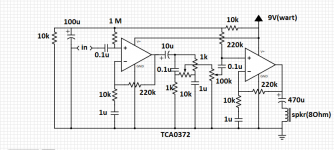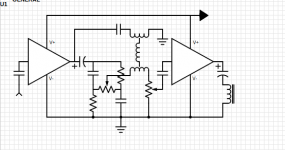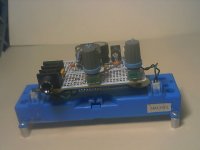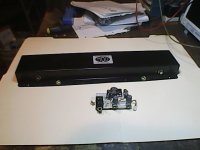One of these :
https://www.eminence.com/pdf/Legend_1518.pdf
On a 2 ' x 2 ' board leaning in corner ......
https://www.eminence.com/pdf/Legend_1518.pdf
On a 2 ' x 2 ' board leaning in corner ......
Just another example that most of the time the amp is overestimated while the speaker is underestimated imho.
Amen Brother.
People will discuss to agonizing detail magic capacitors and resistors which will change response by fractions of a dB, if at all, while speakers are ignored ... and these provide HUGE 10/12dB peaks and throughs all over the place.
Just check any speaker frequency response curve.
People will discuss to agonizing detail magic capacitors and resistors which will change response by fractions of a dB, if at all, while speakers are ignored ... and these provide HUGE 10/12dB peaks and throughs all over the place.
Just check any speaker frequency response curve.
I was playing with the same idea (only daydreaming, though) of simple guitar amp of this kind, so it is nice to see a real-world implementation, with good results.I have tried with 1M input w/buffer. There is somewhat better highs, but for my purpose
( part of which is the elegance of simple circuits ) the tone is OK as is .
I understand the appeal of the elegance of (overly) simple circuits, but in this case fixed gain chip TDA1517 also fixes input impedance to a somewhat low value (for a guitar). Another non-fixed-gain stereo chip with external resistors (for setting the gain and input impedance) don't need separate buffer and should bring a little better sound at the cost of increased resistors count, but the circuit remains simple and elegant as well. If you try this, please post your findings back here.
I have tried many chips .
This one approaches your suggestion :
https://www.st.com/resource/en/datasheet/CD00000134.pdf
With my chosen proto-boards :
Pololu - Adafruit Perma-Proto Half-Sized Breadboard PCB (3-Pack)
The DIL package works much better than DIP .
Another similar :
https://www.mouser.com/datasheet/2/308/TCA0372-D-116057.pdf
Nice DIL but too much gain and needs 2 :
https://www.mouser.com/datasheet/2/308/EN3309-D-119287.pdf
I wellcome any further suggestions ............
This one approaches your suggestion :
https://www.st.com/resource/en/datasheet/CD00000134.pdf
With my chosen proto-boards :
Pololu - Adafruit Perma-Proto Half-Sized Breadboard PCB (3-Pack)
The DIL package works much better than DIP .
Another similar :
https://www.mouser.com/datasheet/2/308/TCA0372-D-116057.pdf
Nice DIL but too much gain and needs 2 :
https://www.mouser.com/datasheet/2/308/EN3309-D-119287.pdf
I wellcome any further suggestions ............
Not too shabby! Good inexpensive diy beginner or practice amp.
Yea .......... Next add a cheapo reverb spring ....
Since the 1rst stage is a power amp it can drive
an 8 Ohm in spring 🙂
Since the 1rst stage is a power amp it can drive
an 8 Ohm in spring 🙂
Get any cheap used Distortion pedal, simply use it as a front end (all have 470k to 1M input impedance) .
I mean, the cheapest ones, which do NOT have True Bypass but in general have an input buffer.
And even if it does, then leave it always ON, with volume set to 10 , Distortion to 0 and Tone, if available, to some point neutral where it does not affect your sound.
Plan B: I can suggest a simple input buffer for your current chipamp, built with no PCB and fed from the internal power supply.
I mean, the cheapest ones, which do NOT have True Bypass but in general have an input buffer.
And even if it does, then leave it always ON, with volume set to 10 , Distortion to 0 and Tone, if available, to some point neutral where it does not affect your sound.
Plan B: I can suggest a simple input buffer for your current chipamp, built with no PCB and fed from the internal power supply.
Plan A ...........
Then I might as well buy an amp or :
Onboard 2.5 Watt Guitar Amp- Drive a speaker OR Headphones!
Plan B ............
I've already tried both a jfet and op-amp buffer ( as I've said ( for my purposes ( other's may vary ) ) )
Spoils my elegance ........ 🙂
I will perhaps try again a chip with inherent higher input Z .
Perhaps :
https://www.mouser.com/datasheet/2/294/NJM2073_E-535376.pdf
Then I might as well buy an amp or :
Onboard 2.5 Watt Guitar Amp- Drive a speaker OR Headphones!
Plan B ............
I've already tried both a jfet and op-amp buffer ( as I've said ( for my purposes ( other's may vary ) ) )
Spoils my elegance ........ 🙂
I will perhaps try again a chip with inherent higher input Z .
Perhaps :
https://www.mouser.com/datasheet/2/294/NJM2073_E-535376.pdf
Looks interesting.
What sort of current draw does this use?
How does this one sound compared to the other one you auditioned (YouTube)?
What sort of current draw does this use?
How does this one sound compared to the other one you auditioned (YouTube)?
I just ordered some bare boards to complete a prototype. I'll measure and do another YouTube when completed . You can probably glean the current draw from this : https://www.onsemi.com/pub/Collateral/TCA0372-D.PDF I am amazed that a DIP8 can produce so much sound ! I am also going to make a stereo amp with the same chip .
Last edited:
With 9 V actually not that much more power ...... But that seems enough for my studio .
BUT ........... It can be powered up with a heftier wart .
BUT ........... It can be powered up with a heftier wart .
- Status
- Not open for further replies.
- Home
- Live Sound
- Instruments and Amps
- Move over Fender and Marshall



